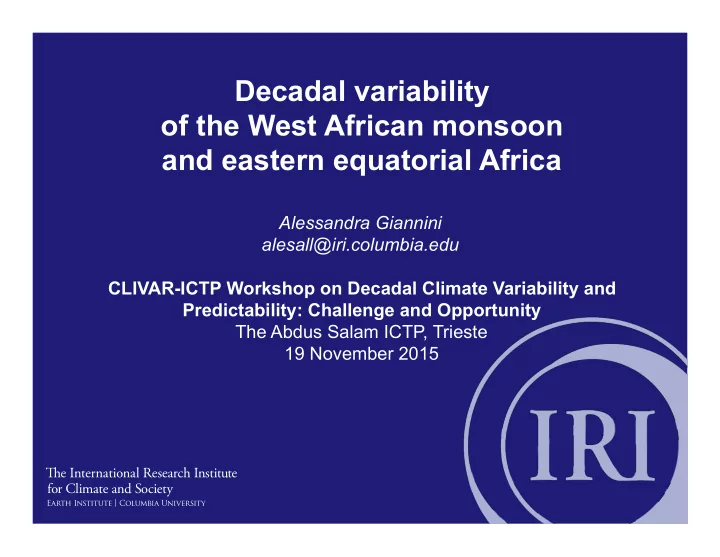

Decadal variability of the West African monsoon and eastern equatorial Africa Alessandra Giannini alesall@iri.columbia.edu CLIVAR-ICTP Workshop on Decadal Climate Variability and Predictability: Challenge and Opportunity The Abdus Salam ICTP, Trieste 19 November 2015 Te International Research Institute for Climate and Society
Two themes/threads Physical processes can be made sense of that explain regional precipitation variations across time scales, from days to decades, and connect [natural] variability and [anthropogenic] change Ø What controls vertical instability? [and how do oceans contribute?] Decadal scale is evident. It comes from oceanic forcing v Anthropogenic influence [GHGs, aerosols…] can also be argued indirectly, through oceans Te International Research Institute for Climate and Society
African drylands: margins of convection? GPCP 1979-2015 Te International Research Institute for Climate and Society
Sahel/West African monsoon Te International Research Institute for Climate and Society
Decadal variation is evident. Oceanic forcing of late 20 th century Sahel drought [and recovery] is also evident. Giannini, A, R Saravanan and P Chang 2003, in Science Te International Research Institute for Climate and Society
Which oceans? Atlantic and Indian on decadal, tropical Pacific on interannual time scales Te International Research Institute for Climate and Society Giannini, A, R Saravanan and P Chang 2003, in Science
Reinterpreting conventional wisdom… [cartoon is from Zeng 2003, in Science] Te International Research Institute for Climate and Society
Reinterpreting conventional wisdom… (1/2) the global tropical oceans set the threshold for deep convection e.g., “upped ante” ¡ Neelin et al. 2003, in Geophys Res Lett Chou and Neelin 2004, in J Climate Held et al. 2005, in PNAS Held and Soden 2006, in J Climate Te International Research Institute for Climate and Society
Reinterpreting conventional wisdom… (2/2) the local ocean provides the moisture to meet the threshold Te International Research Institute for Climate and Society
The relative temperature of the North Atlantic with respect to the global tropical oceans explains interannual variability rainfall index is from Ali and Lebel 2009, in Int J Clim ¡ ¡ ¡ ¡ ¡ ¡ ¡ ¡ ¡ ¡ 1950-1969 – wet ¡ 1970-1989 – dry 1990-2006 – variable open circles are negative anomalies – dry full dots are positive anomalies – wet Giannini, Salack, Lodoun et al. 2013 in Env Res Lett Te International Research Institute for Climate and Society
The relative temperature of the North Atlantic with respect to the global tropical oceans in frequency (left) and intensity (right) of daily rainfall in Senegal (1950-2010) ¡ ¡ ¡ ¡ ¡ ¡ ¡ ¡ ¡ ¡ ¡ ¡ ¡ ¡ open circles are negative anomalies full dots are positive anomalies Giannini, Salack, Lodoun et al. 2013 in Env Res Lett Te International Research Institute for Climate and Society
The recent evolution of Sahel rainfall: anomalously wet, persistently dry, increased variability? Agrhymet, 2010 Te International Research Institute for Climate and Society
The recent evolution of Sahel rainfall: anomalously wet, persistently dry, increased variability? Agrhymet, 2010 North Atlantic – global mean Indian Ocean Sahel rainfall ¡ Te International Research Institute for Climate and Society
The recent evolution of Sahel rainfall: anomalously wet, persistently dry, increased variability? Agrhymet, 2010 Te International Research Institute for Climate and Society
The recent evolution of Sahel rainfall: anomalously wet, persistently dry, increased variability? Agrhymet, 2010 Te International Research Institute for Climate and Society
The recent evolution of Sahel rainfall: anomalously wet, persistently dry, increased variability? Agrhymet, 2010 Te International Research Institute for Climate and Society
eastern equatorial Africa Te International Research Institute for Climate and Society
Importance of Indian Ocean for simulating East African rainfall Goddard and Graham 1999 in J Geophys Res
Resolving contrasting regional rainfall responses to El Niño over tropical Africa Parhi et al. J Climate, in press frequency [left] and median intensity [right] of daily rainfall during the east African short rains [daily rainfall data from CPC unified gridded product] Te International Research Institute for Climate and Society
Tropical Pacific forcing of a 1998–1999 climate shift leading EOF/PC of MAM CMAP precipitation over the period 1979–2011 Lyon et al. in Clim Dyn 2014
Tropical Pacific forcing of a 1998–1999 climate shift 1999–2012 minus 1979–1998 differences in ERSST, CMAP precipitation ( p < 0.10) and 850 hPa wind from R2 Lyon et al. in Clim Dyn 2014
Tropical Pacific forcing of a 1998–1999 climate shift leading EOF of the MAM residual* SST data evaluated over the period 1900–2012 Lyon et al. in Clim Dyn 2014 *after removing ENSO and global trend
Conclusions 1. Decadal scale is evident. It comes from oceanic forcing v Atlantic and Sahel v Pacific and eastern equatorial Africa 2. Current theories that exploit the El Niño analogue to understand the response of deep convection to global warming can be applied to processes at work on time scales from sub-seasonal to multi-decadal Te International Research Institute for Climate and Society
Thank you! alesall@iri.columbia.edu ¡ web: iri.columbia.edu @climatesociety …/climatesociety T e International Research Institute for Climate and Society
The difference between sub-tropical North Atlantic and global tropical sea surface temperature explains past drought and potential future recovery Past Green: end 20 th century – pre-Industrial Giannini, Salack, Lodoun et al. Blue: end – beginning 20 th century 2013, in Env Res Lett Future Te International Research Institute Yellow: mid-21 st (A1B) – end 20 th for Climate and Society Red: end 21 st – end 20 th
Recommend
More recommend